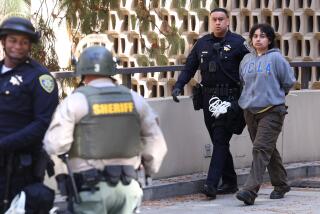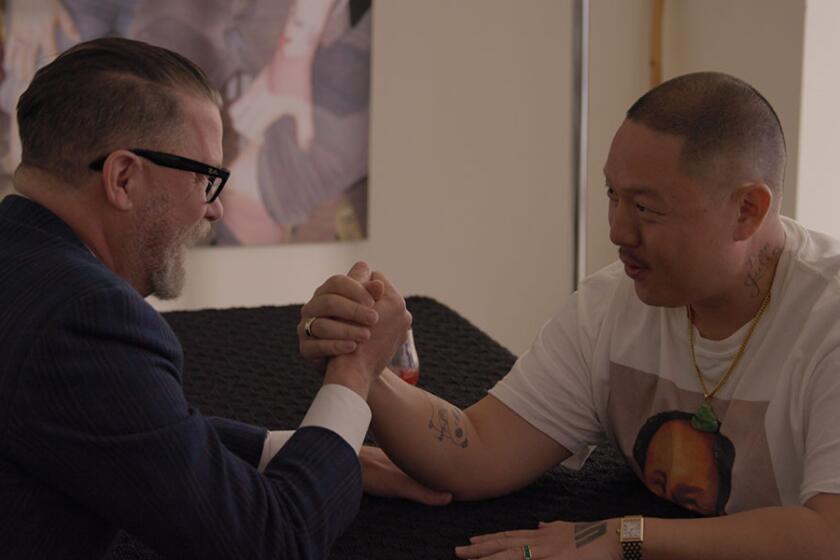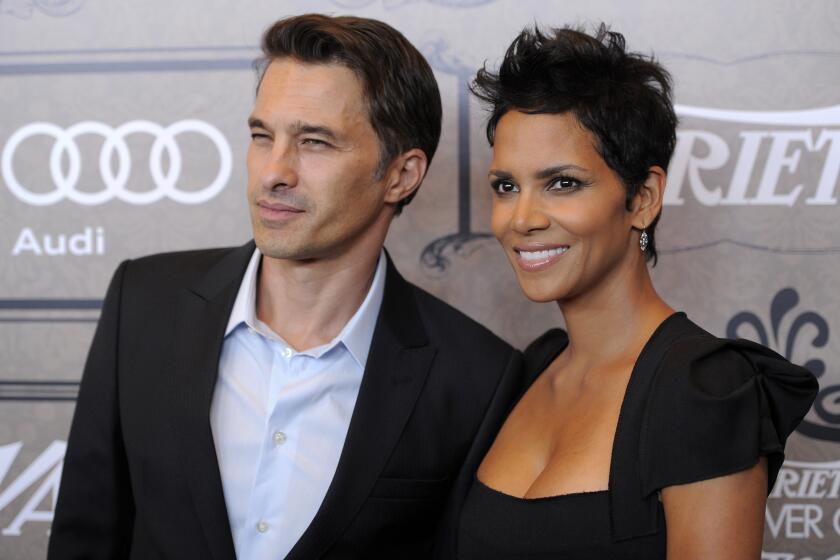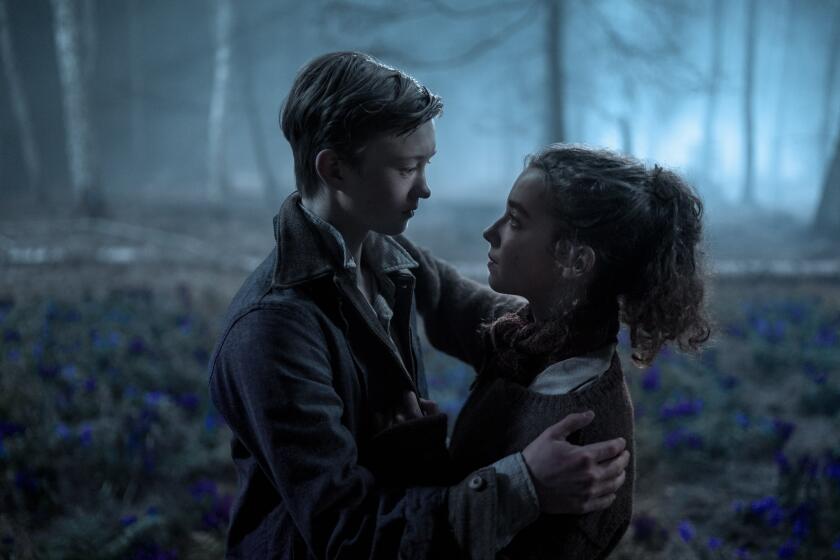Laying It on the Line : We brought together John Singleton and a group of college students to see if ‘Higher Learning’ made the grade. Life on campus ended up sharing the bill with the Hollywood game.
‘Question the knowledge,” commands the poster for director John Singleton’s latest film, “Higher Learning,” which takes on university life in the ‘90s.
And a group of college students got a chance to do just that recently when Singleton allowed himself and his new film to be questioned by 10 students of diverse backgrounds from UCLA, USC and Cal State L.A. in a round-table discussion on the Columbia lot.
The challengers: Dale Howard, Celine Salazar, Sumi Lee and Noah Coleman from UCLA; Patricia Barron, Rick Famuyiwa, Traci Brown and Jon Soske from USC; and Jason Timmons and Lesley Lee from Cal State L.A.
Todd Boyd, an associate professor of critical studies at USC’s School of Cinema-Television, who this semester is teaching a course in race, class and gender, joined the students in testing the issues in “Higher Learning” against their own experiences as currently enrolled university students.
“I want you guys to let loose,” Singleton began. “I want to hear the pros and the cons of how the movie made you feel. If you liked the movie, fine; if you didn’t like the movie, fine. If the movie upset you, I want to hear why the movie made you upset.
“For me, the film was on the level of a documentary about what really happens on a university campus. You see the movies about college and they’re about getting laid, or getting drunk, or fraternity parties, but no one really takes on how you have to struggle every semester.”
“Higher Learning,” which opened Wednesday, takes place on the campus of fictional Columbus University, a private academic institution located somewhere in California, which bears a resemblance to Singleton’s own alma mater, USC. While Singleton acknowledges that he drew upon his own experiences while writing the screenplay, the film is also packed with issues burning on today’s campuses: cultural diversity, date rape, homophobia, institutional and social racism, ever-rising tuition, and what some see as the exploitation of college athletes.
The film follows the stories of three freshmen entering Columbus: Kristen (Kristy Swanson), a young white woman from Orange County (“Is that near Compton?” she’s asked by her African American roommate; “No, Disneyland,” she replies); Malik (Omar Epps), who at first assumes that his athletic scholarship means a free ride; and Remy (Michael Rappaport), an emotionally disturbed engineering student who eventually finds the acceptance he’s seeking from a group of skinheads.
The subtle tensions among racial and cultural groups simmer throughout the film until they erupt in a violent, bloody climax.
After viewing the film, one of the first issues tackled by the group was compromise. In “Higher Learning,” Malik, a black track star on a scholarship, questions the extent to which he should “play the game” in college. Malik is torn between the words of his professor (Laurence Fishburne), who pushes him to make the most of this chance at an education, and those of Fudge (Ice Cube), a fellow student who’s a charismatic exponent of Black Power who urges Malik to shun the system that is exploiting him.
Todd Boyd: I think a number of people in our society assume that the educational system is immune to or free of racism, that somehow universities have an egalitarian approach to society in which everybody comes together and learns. And from the film and just from living and from my perspective as a professor, we know that’s not the case. . . . A lot of people take the university system for granted. . . . It wasn’t that long ago when people weren’t able to go to school in such mass numbers.
Dale Howard (addressing Singleton): The message you were trying to convey, was it to not forget your identity? . . . Because the majority of America is white-owned and run, and if you graduate and you’re a minority, you are going to have to play the (white) game for at least a little while.
Boyd: Why do you assume that you’re going to have to play the game?
Howard: You’re going to have to do certain things that you don’t feel comfortable with if you want to be successful in America.
Boyd: If there’s any one thing I teach it is that you can be yourself and still get over. Here’s the point: John sits here as a young African American male having made three feature films. If he had accepted the rules, he would never have made one film. I sit here as a young African male, as a professor . . . and if I had accepted the rules and played by the standards that were set, I wouldn’t be here. The point is, if you’re competent, if you know what you’re doing, you can always be yourself.
John Singleton: For me, coming out of college, there were no set rules.
Howard: Are you saying that you made no sacrifices to make this movie?
Singleton: I’m telling you I made as few sacrifices as I could to get this thing made. The movie would not be like it is if I had done what the studio wanted me to do. There are things in this movie that you can honestly say you’ve never seen in a studio movie. I mean, have you? I’m saying there are ways of playing the game and the game is whatever you make it.
Lesley Lee: It’s all in here (she points to her heart and paraphrases from a scene in the film). If you’re competing against someone, another white person, let’s say, who’s equally capable, what do you do? You run faster.
Singleton: Yes, and you don’t blame it on everybody else.
L. Lee: You have to dodge the bullets that are going to come at you, and when you have to dodge the bullets, you learn to be quicker.
*
Early in the film, Kristen, who has been partying with some friends, goes home with a fraternity boy. She agrees to have sex with him, but when he refuses to put on a condom, she pleads with him to stop. He doesn’t. Shattered, Kristen nevertheless never reports the incident. As time passes, she becomes involved with a political group on campus, and finds herself attracted to one of the female activists, a lesbian.
Jon Soske: What were you trying to do by throwing the lesbian in?
Singleton: I didn’t throw her in. It was just part of her experience. I talked to a lot of women on campuses--and plus I went to school four years ago--and I found that it was a part of some girls’ experiences on campuses. So I wanted to have a character that was a lesbian.
Soske: What you have is a stereotype of a lesbian, a beautiful chick lesbian feminist.
Singleton: But if she were an ugly lesbian chick--or what you call ugly--she would have been another stereotype. As far as the rape goes, there’s a fine line there. I wanted people to question whether or not it was a rape.
Patricia Barron: Well, at the rally (a No Means No rally at which Kristen speaks publicly about her experience), they were all yelling, “No! No! No!” and when she was in bed with him, she said the same thing. Although he was already on top of her, obviously that was a rape right there. She was saying, “No, get off.”
L. Lee: And there’s that terrible trap for rape victims that people won’t believe her, or no one will be available.
Soske: Or like how she runs past the emergency phones and doesn’t stop to report it.
L. Lee: Just because you go on a date with this man doesn’t mean he can (expletive) you.
Singleton: Put that in The Times, but change the quote to say: “Just because you do shots with a man doesn’t mean he can (expletive) you.”
The discussion then turned to who is “Higher Learning’s” real racist enemy--Remy and the skinheads, or the university system itself? Increasingly alienated, Remy finds the answer to his frustration in a group of white supremacists who approach him on campus. To prove himself, he eventually takes up arms, first by pulling a gun on his Jewish roommate and then in a far deadlier public showdown on campus. Yet throughout the film, more subtle forms of racism are displayed--from the manner in which the campus police differ in their treatment of white and black students, to such insensitive remarks as, “My roommate’s a Mexican, so you can bet she got a scholarship.”
Rick Famuyiwa: The issues of the film, the way I saw them, were racism, sexism and diversity. As far as the racial issues are concerned, in the film I see an emphasis on the Aryan Nation group rather than on the institution, and I think that was misplaced.
Jason Timmons: But if you put the camera inside the university boardroom, it would be really boring. You have to look at how the institution’s racism shapes individuals. The students are the lifeblood of the university, and in this film, they’re the ones getting hurt.
Boyd: People might say that once you start dealing with educated people, you start moving away from characters like Remy’s, that educated people wouldn’t display that type of position, and obviously that’s not the case. For instance, we’re talking about a very educated group of elite who were leading the Nazis during that period. We’re not talking about idiots off the street.
Soske (addressing Singleton): I don’t think you talk about the racism of the system.
Singleton: You don’t think I talk about the racism of this system?
Soske: No, I don’t think so. You don’t see any university employees committing a racist act, or any white, straight, hip people being the racists. It was all the pariah skinhead thugs.
Noah Coleman: Well, the cops were racist. (Huge outbreak of laughter from the group.)
Soske: The police are an easy icon of racism.
Singleton: But that wasn’t the purpose of the movie to show every white male as being a racist. What about the fraternity guys? They’re racists and sexists, but it’s more subtle.
Traci Brown: When I came to college (USC), I knew that because it was predominantly white there would be some problems. But at the same time I was expecting more of a bond together. It’s true there’s Little Asia (in “Higher Learning,” the students segregate themselves when hanging out on campus, with the whites in “Disneyland,” the Asians in “Chinatown,” the Latinos “South of the Border” and the African American students in the “Black Hole”). And even within the groups like the Black Student Union, certain black people don’t want to come for this, that and the other reason. Divided among ourselves, how can we be united? It’s like you go to the Row (Fraternity Row) for a party and you’re Latino, it’s somewhat uncomfortable. Even if people may be friendly, there’s this undertone of “you don’t belong.”
Celine Salazar: It’s not the skinheads that really got me (in the movie); it was the fraternity scenes (one in which black students are made to feel uncomfortable, and another in which two white female students, after a disturbance involving some black students, say, “Why do they always have to cause trouble?”), because that’s the racism I see on campus at UCLA.
Patricia Barron: What about the subtle shot when Kristen’s in the elevator with Malik and she puts her hand on her purse?
Singleton: But she’s not a racist. Is she a racist because she looks at the black man with fear? You have to think about why she looks at her purse.
Sumi Lee: It’s social racism; she’s still affected by it and that scares me. Yes, it’s subtle, but it scares me more.
Soske: But that’s not the racism I see as the problem at USC. The elements are there (in the film), but the major enemies are the clean-cut skinhead.
Singleton (becoming agitated): What about Billy (the fraternity member who date-rapes Kristen)? He rapes a woman and then calls another woman (Kristen’s roommate) a “black bitch” out of frustration, out of social racism.
Soske: But that’s a frat guy. You expect that from a frat guy.
Singleton: No! That’s stereotyping! (crowd murmurs in agreement)
Soske (to Singleton): But you’re the one who put the stereotype on the screen! That’s a stereotype of frat guys. You don’t portray the men in offices making decisions there. It’s the small things. When at USC did you see a group of skinheads come beat people up?
Singleton: Never, because USC’s in a black neighborhood, they’d get whacked. But there are other universities where they’re there, they’re at the University of Texas and Alabama. They’re right alongside the football players!
Soske: I think there’s enough of a story with racism on campus, racism within the institution, with rape, with homophobia, that you could make the same point without the skinheads. I think you’ve taken a lot of edge away from what you’re doing.
Singleton (amused): I like that, but I didn’t want to do that on the nail like Oliver Stone would. This is great, you know, it makes me wish I’d taken a stronger stand--and the movie was really hard to get made as it was! My goal is to make people like you sit around and talk to each other like human beings and not feel you’re scared to talk to each other because you’re scared of any kind of dialogue.
Boyd: What it comes down to is that college is a condensation of what happens in society, all of this is linked up. The same way the skinheads and the security officers are linked up. It’s like Ice Cube says in one of his songs: The same man who put me in the slammer / He bombed a church in Alabama. It’s all the same thing, it just takes place in different forms.
L. Lee: Throughout the whole film, it’s either black or white. Where am I? I mean, it’s not like I’m so hard-core to say that because I didn’t see any Asian American faces that I would jump over to another theater.
S. Lee: Well, why aren’t there more Asian characters in the movie? (Crowd laughs; someone shouts, “Here we go!”) I did notice that when there were Asians, they were really passive--what’s up with that? I mean, at UC campuses Asians aren’t even considered minorities. So since we make up such a large population at the universities, why wasn’t there a main Asian character?
Singleton: I wrote one, actually. . . . But I can’t do everything. I promise you a movie with more Asians that’s well-rounded. There’s only so much I can put into one movie.
More to Read
Only good movies
Get the Indie Focus newsletter, Mark Olsen's weekly guide to the world of cinema.
You may occasionally receive promotional content from the Los Angeles Times.










